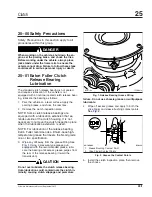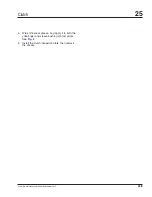
20–00 Safety Precautions
Safety Precautions in this section apply to all
procedures within this group.
DANGER
When working on the vehicle, shut down the en-
gine, set the parking brake, and chock the tires.
Before working under the vehicle, always place
jack stands under the frame rails to ensure the
vehicle cannot drop. Failure to follow these steps
could result in serious personal injury or death.
20–01 Pressure Relief Cap
Check
WARNING
Do not remove or loosen the surge tank cap until
the engine and cooling system have completely
cooled. Use extreme care when removing the cap.
A sudden release of pressure from removing the
cap prior to the system cooling can result in a
surge of scalding coolant that could cause seri-
ous personal injury.
1.
Remove the fill cap, first, to relieve the cooling
system pressure, then remove the SAE cap.
2.
Using a radiator-cap tester, check the pressure
cap to see if it maintains pressure to within 10%
of the pressure rating marked on the cap. If it
doesn’t, replace the cap. See
. Make sure
that the replacement radiator cap is correctly
rated for the cooling system of the vehicle.
3.
There is a second valve in the radiator cap that
opens under vacuum. This prevents the collapse
of hoses and other parts that are not internally
supported when the system cools. Inspect the
vacuum-relief valve to be sure it is not stuck.
4.
Make sure that the cap seals properly on the
coolant filler neck seat, and that the radiator cap
gasket is not damaged. On vehicles with
screw-on caps with O-rings, make sure that the
O-ring is not cracked or deteriorated. Replace
the cap if the gasket shows deterioration or dam-
age.
20–02 Radiator Pressure-
Flushing and Coolant
Change
NOTE: For additional instructions on cleaning
and flushing the engine cooling system, see the
applicable engine manufacturer’s maintenance
and operation manual.
1.
Park the vehicle and apply the parking brakes.
Tilt the hood.
2.
Place a suitable container under the elbow of the
radiator outlet pipe and the radiator. The con-
tainer should hold at least 60 quarts (59 liters) of
fluid.
WARNING
Do not remove or loosen the surge tank cap until
the engine and cooling system have completely
cooled. Use extreme care when removing the cap.
A sudden release of pressure from removing the
cap prior to the system cooling can result in a
surge of scalding coolant that could cause seri-
ous personal injury.
3.
Remove the surge tank cap.
WARNING
Do not attempt to drain the cooling system until
the coolant and engine are cool. Draining the
cooling system prior to the system cooling could
cause severe personal injury due to scalding.
4.
Remove the drain plugs at the radiator side tank
and at the lower radiator outlet pipe elbow. See
. Allow the coolant to drain.
5.
Disconnect the radiator upper and lower hoses,
and install the surge tank cap. Attach the flushing
gun nozzle to the radiator at the lower radiator
hose opening. Run the water until the radiator is
full.
CAUTION
When flushing the radiator, do not apply more
than 15 psi (100 kPa) air pressure. Excessive pres-
sure can damage the radiator.
Engine Cooling/Radiator
20
Columbia Maintenance Manual, September 2015
20/1
Содержание CL112 2015
Страница 2: ......
Страница 4: ......
Страница 10: ......
Страница 32: ......
Страница 34: ......
Страница 38: ......
Страница 40: ......
Страница 42: ......
Страница 44: ......
Страница 46: ......
Страница 48: ......
Страница 50: ......
Страница 52: ......
Страница 60: ......
Страница 62: ......
Страница 66: ......
Страница 68: ......
Страница 74: ......
Страница 86: ......
Страница 94: ......
Страница 96: ......
Страница 104: ......
Страница 106: ......
Страница 116: ......
Страница 118: ......
Страница 120: ......
Страница 122: ......
Страница 128: ......
Страница 140: ......
Страница 142: ......
Страница 152: ......
Страница 156: ......
Страница 164: ......
Страница 166: ......
Страница 168: ......
Страница 172: ......
Страница 176: ......
Страница 178: ......
Страница 180: ......


































